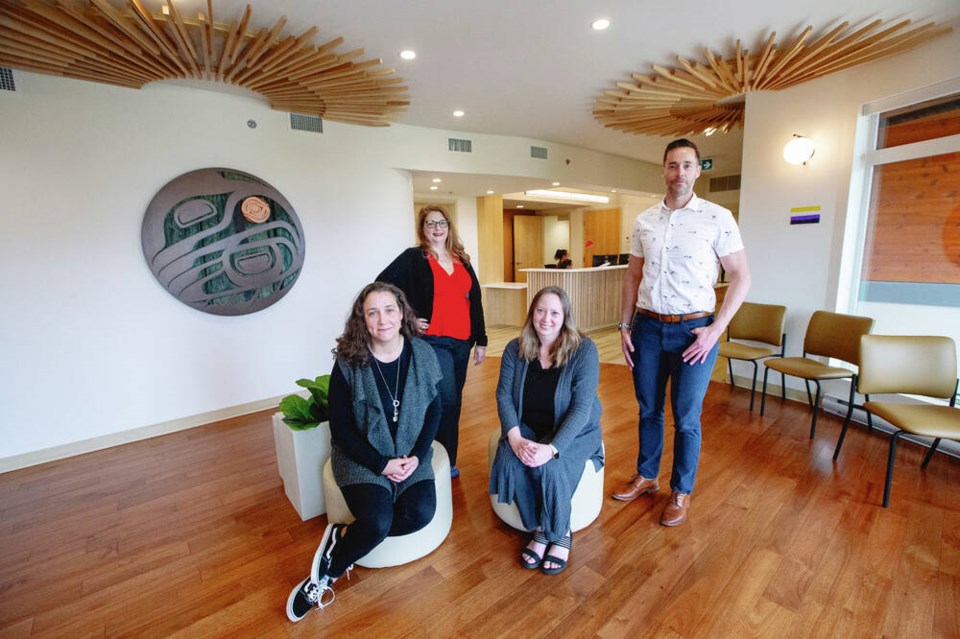A new medical clinic that aims to provide primary care for 6,700 patients in Colwood, Langford, Highlands and Metchosin opened its doors this week.
Three years in the making, the 5,400-square-foot Westshore Community Health Centre, located at the Pacific Centre Family Services Association on Goldstream Avenue in Colwood, is the third of its kind in Greater Victoria, along with Island Sexual Health and Luther Court in Saanich, which is expected to open in about a month.
Open six days a week, the West Shore centre will be staffed by nine doctors along with nurse practitioners, registered nurses, a social worker and community health workers.
It is not a walk-in clinic, and patients disproportionately affected by unstable housing, substance-use, mental-health and social-services issues will be priorities. Patients who believe they are in a priority group need to register through the province’s new central registry, Health Connect Registry.
Dr. Jennifer Ross said the centre will provide chronic-disease management, prenatal and postpartum care, prescription refills, mental-health assessment and treatment, substance-use-disorder services, screening, and referrals to medical specialists and social services.
A few doctors, including Ross and Dr. Randal Mason, are moving their practices to the centre, while the majority of the physicians and nurse practitioners are new hires. “We’re very excited, we’re very invested,” Ross said. “We’ve been working on this for quite a few years and we’re both very strong leaders in equity-based health care and passionate about serving historically oppressed groups — bringing services to people who really need it.”
The West Shore has about 60,000 patients without a family doctor, up from 35,000 in 2016 due to a “population explosion” and physician retirements, said Ross. In B.C., about 900,000 people are without a family doctor.
Premier John Horgan said access to primary-care services is a challenge for people in the West Shore and across B.C. and the new centre will bring “health care closer to home.”
B.C. Health Minister Adrian Dix said Friday he’s exceptionally proud of the centre and that it will play a vital role “to help connect residents who have been struggling to access a family doctor.”
The province has for years had a three-pronged primary care strategy: urgent and primary care centres, community health centres and primary care networks, which co-ordinate resources between clinics to provide team-based care.
The West Shore became home in November 2018 to the Island’s first urgent and primary care centre, designed to alleviate pressure on hospital ERs and provide a team-based care model. The UPCCs opened to much fanfare, but have more recently been criticized for long wait times and understaffing.
Ross hopes the community health centre will take pressure off UPCCs as well as ERs and the hospital system. “People who are struggling more with the social determinants of health tend to be higher users of the acute-care system, so if we’re able to attach them to longitudinal care, we can address their concerns within this facility. That being said, there are 65,000 unattached patients in the West Shore, so whether we can make a visible dent is unknown, but that’s certainly our hope.”
Community health centres, like UPCCs, offer team-based care and pay physicians on contracts and salaries rather than the fee-for-service model that is the norm in private family practices, where compensation depends on how many patients a physician sees and how many procedures they perform.
Community health centres differ in that they are governed by a community board of directors — usually a non-profit or co-operative — and are tailored to meet the health needs of the communities they serve.
The idea for the Westshore Community Health Centre began to come together in 2019, when Ross and Mason looked at new primary-care network funding for health-care providers, the resources already established in the community, and the “priority populations” that needed to be served, and found a large gap in services.
“Our mandate is to look really closely at the social determinants of health and the population as a whole in the region and and seek out those people who are more directly impacted by things like poverty and unstable housing and so on,” said Ross.
While common in Ontario, community health centres are rarer in B.C., where they tend to be in inner cities. Ross acknowledges the West Shore is not the typical location.
“So it’s true that if you drive around the West Shore, you’ll see lots of new housing and an increasing number of expensive cars and so on,” said Ross.
“But you don’t actually have to look very hard to see that there’s also quite a few people living in their vehicles out here, people who don’t have access to the basic necessities of life. There are people who are struggling with mental-health and substance-use disorders and have nowhere to go for care.”
A collaboration between the Health Ministry, Island Health, Pacific Centre Family Services Association and South Island Division of Family Practice, the Westshore Community Health Centre will be operated by the association and Island Health.
The province will pay about $4 million in annual operating funding once the centre reaches full capacity, and up to $1.9 million in startup costs.



